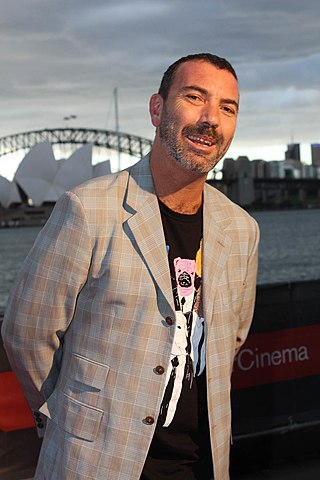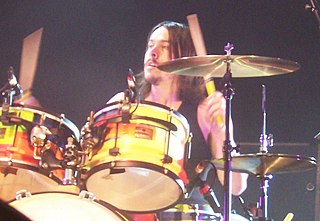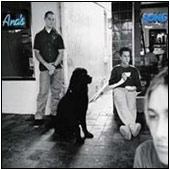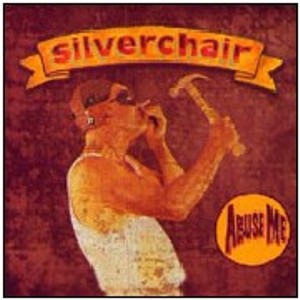
Daniel Paul Johns is an Australian musician, singer, and songwriter, best known as the frontman, guitarist, and main songwriter of the rock band Silverchair. Johns is also one half of The Dissociatives with Paul Mac and one half of Dreams with Luke Steele. He released his first solo album, Talk, in 2015. Johns' second solo album, FutureNever, was released on 22 April 2022.

Silverchair are an Australian rock band, which formed in 1992 as Innocent Criminals in Newcastle, New South Wales, with Daniel Johns on vocals and guitars, Ben Gillies on drums, and Chris Joannou on bass guitar. The group got their big break in mid-1994 when they won a national demo competition conducted by SBS TV show Nomad and ABC radio station Triple J. The band was signed by Murmur and were successful in Australia and internationally. Silverchair has sold over 10 million albums worldwide.

Paul Francis McDermott, who performs as Paul Mac, is an Australian electropop musician, singer-songwriter, producer and music re-mixer. He was classically trained at Sydney Conservatorium of Music. Mac has formed various bands including Smash Mac Mac (1986–88), The Lab (1989–1998), Itch-E and Scratch-E (1991–present), Boo Boo Mace & Nutcase (1996–98), and The Dissociatives (2003–2005). Mac has released two solo albums, 3000 Feet High and Panic Room – both appeared in the top 40 on the ARIA Albums Chart.
The Dissociatives were an Australian alternative rock band consisting of Daniel Johns of Silverchair and dance producer and DJ Paul Mac, which formed in mid-2003. They were supported by touring members, Julian Hamilton and Kim Moyes, and James Haselwood. Their first single "Somewhere Down the Barrel" peaked at No. 25 on the ARIA Singles Chart. The duo's debut album The Dissociatives reached No. 12 on the ARIA Albums Chart. At the ARIA Music Awards of 2004 they won two trophies; Best Cover Art for James Hackett's work on The Dissociatives and Best Video for Hackett's direction of "Somewhere Down the Barrel".

Frogstomp is the debut studio album by Australian rock band Silverchair. It was released on 27 March 1995, when the band members were only 15 years of age, by record label Murmur. The album features the band's commercially most successful single, "Tomorrow".

Benjamin David Gillies is an Australian musician, best known as the drummer of Australian rock band Silverchair from 1992 until the band went on hiatus in 2011. In 2003, Gillies formed Tambalane with Wes Carr, initially as a songwriting project; they released a self-titled album in 2005 and toured Australia but subsequently folded. By June 2011, after Silverchair's disbandment, Gillies was in the final stages of about 12 months of working on his solo album, and he said that it was not a continuation of his earlier work with Tambalane. In 2012, he formed Bento, in which he performs lead vocals, and released the band's debut album Diamond Days.

Diorama is the fourth studio album by Australian alternative rock band Silverchair, released on 31 March 2002 by Atlantic/Eleven. It won the 2002 ARIA Music Award for Best Group and Best Rock Album. The album was co-produced by Daniel Johns and David Bottrill. While Bottrill had worked on albums for a variety of other bands, Diorama marked the first production credit for lead singer Johns.

Young Modern is the fifth and final studio album by Australian alternative rock band Silverchair, released on 31 March 2007 and co-produced by Daniel Johns and Nick Launay. The title comes from a nickname given to Daniel Johns by composer Van Dyke Parks. The tracks "Straight Lines", "Reflections of a Sound", "If You Keep Losing Sleep" and "Mind Reader" were released as singles. Young Modern entered the Australian albums chart at No. 1 on 15 April 2007, their fifth consecutive album to do this, making Silverchair the first band to accomplish this feat in Australia. The album was certified Triple Platinum by the ARIA, peaked at No. 70 on the US Billboard 200 chart and opened at No. 8 on the New Zealand albums chart. Young Modern won six ARIA Awards in 2007, including Best Group, Best Rock Album, Single of the Year and Album of the Year. At the J Awards of 2007, the album was nominated for Australian Album of the Year.

The Best Of: Volume 1 is the first compilation album by Australian alternative rock band Silverchair, which was issued on 13 November 2000. It includes every single they had released up until that point, with the exception of "Shade". The album peaked at No. 15 on the ARIA Albums Chart.

"Tomorrow" is a song by Australian rock band Silverchair, which was released on 16 September 1994 on their debut extended play album, also titled Tomorrow. The song was later released on Frogstomp, the band's debut studio album, in 1995. Written by lead singer and guitarist Daniel Johns and drummer Ben Gillies, it was produced and engineered by Phil McKellar at the national radio station Triple J's studios for SBS-TV's show, Nomad, which aired on 16 June 1994. After the broadcast the band were signed to the Murmur label – a Sony Music subsidiary – which subsequently issued the Tomorrow EP.

"Without You" is a song by Australian rock band Silverchair, released as the second single from their fourth album, Diorama (2002), on 13 May 2002. It was written by lead singer-guitarist Daniel Johns and was composed during the recording sessions for the band's third album Neon Ballroom (1999) but was not used at that time.

"Ana's Song (Open Fire)" is a song by the Australian alternative rock band Silverchair. It was released in May 1999 as the second single from their third album, Neon Ballroom. The song is about lead vocalist Daniel Johns' struggle with anorexia nervosa. "Ana's Song" peaked at No. 14 on Australia's ARIA Singles Chart, at No. 12 on the US Billboard Modern Rock Tracks chart, and at No. 28 on the Billboard Mainstream Rock Tracks chart. At the ARIA Music Awards of 1999, it was nominated for two awards. The track also earned Silverchair a Comet Award in Germany.

"Miss You Love" is a song by the Australian rock band Silverchair. It was released as the third single from their 1999 album Neon Ballroom. AllMusic critic Jason Anderson called the song a weepy ballad reminiscent of Goo Goo Dolls.

"Anthem for the Year 2000" is a song by Australian rock band Silverchair, released as the first single from their third album, Neon Ballroom. The song reached number three on the Australian ARIA Singles Chart, becoming the band's sixth top-ten single and their first lead single from an album not to reach number one, a feat "Tomorrow" and "Freak" had accomplished. The song reached the top ten in New Zealand, on Canada's RPM Rock Report, and on the UK Rock Chart.

"Abuse Me" is a song by the Australian rock band Silverchair. It was released as the second single from their 1997 album, Freak Show. In the United States, Sony chose "Abuse Me" as the first single from Freak Show despite protests by the band's manager. "Freak" was the Australian lead single and the preferred lead single from the album. It was also released on their The Best of Volume 1. The single peaked at number four on both the Billboard Modern Rock Tracks and Mainstream Rock Tracks charts, making it their second biggest hit in the United States.

The discography of Silverchair, an Australian alternative rock band, consists of five studio albums, one extended play (EP), twenty singles, one live album, two compilation albums, four video albums, and twenty music videos.
The 13th Australian Recording Industry Association Music Awards was held on 12 October 1999 at the Sydney Entertainment Centre. Hosted by Paul McDermott and Bob Downe, and presenters, including Melanie C of the Spice Girls, Tina Cousins, Fiona Horne and Molly Meldrum, distributed 33 awards. The big winner for the year was Powderfinger with four awards.

Savage Garden were an Australian pop duo consisting of Darren Hayes on vocals and Daniel Jones on guitar, keyboards, and vocals; they formed in Brisbane, Queensland, in 1993. They were signed to John Woodruff's talent agency and achieved international success with their No. 1 hit singles "I Want You", "To the Moon and Back", "Truly Madly Deeply" (1997), and "I Knew I Loved You" (1999).

Freak Show is the second studio album by Australian rock band Silverchair. It was recorded during May–November 1996 and released on 4 February 1997 by record labels Murmur and Epic. It was nominated for the 1997 ARIA Music Award for Best Group, but lost to Savage Garden.
"Emotion Sickness" is a song by the Australian alternative rock band Silverchair. It was released as the first song on their 1999 album Neon Ballroom. At 6 minutes long, it is the band's third-longest song. Australian pianist David Helfgott makes a guest appearance on the song, along with the Sydney Symphony Orchestra. In a 1999 interview with Metal Hammer, Daniel Johns said that "Emotion Sickness" is his favorite Silverchair song.















